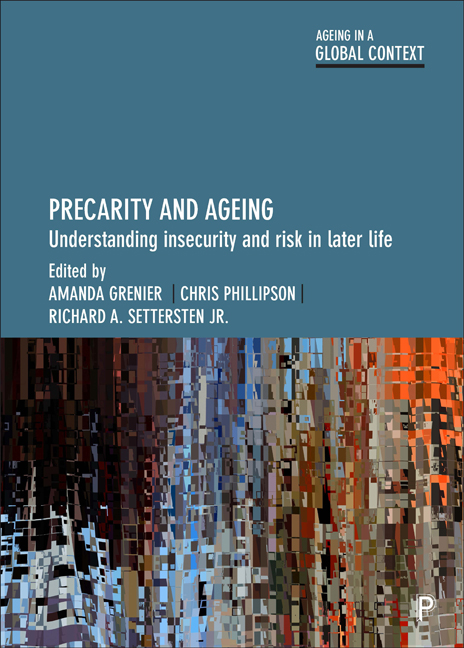Book contents
- Frontmatter
- Contents
- List of Figures and Tables
- Notes on Contributors
- Editors’ Acknowledgements
- Series Editors’ Preface
- 1 Precarity and Ageing: New Perspectives for Social Gerontology
- PART I Life Course Perspectives on Precarity
- PART II Precarity Across Situations
- PART III Austerity, Care and Social Responses to Precarity
- Index
4 - Rereading Frailty Through a Lens of Precarity: an Explication of Politics and the Human Condition of Vulnerability
Published online by Cambridge University Press: 02 March 2021
- Frontmatter
- Contents
- List of Figures and Tables
- Notes on Contributors
- Editors’ Acknowledgements
- Series Editors’ Preface
- 1 Precarity and Ageing: New Perspectives for Social Gerontology
- PART I Life Course Perspectives on Precarity
- PART II Precarity Across Situations
- PART III Austerity, Care and Social Responses to Precarity
- Index
Summary
Introduction
Over the last 15 years, frailty has emerged as one of the most powerful constructs in gerontology, geriatrics and health care delivery. Authors from biomedicine have highlighted the clinical importance of the concept (Fried et al, 2001; Rockwood et al, 1994; Rockwood and Mitnitski, 2007), with researchers in the social sciences calling attention to its powerful position in establishing the foundations for medical expertise and disciplining older bodies according to function and risk (Grenier, 2007; Katz, 2011; Pickard, 2014). The concept of frailty appears in countless calls from medical interest groups (Morley et al, 2013; Turner and Clegg, 2014), and is used to frame a number of international research priorities such as the Canadian Frailty Network, as well as national care priorities such as that of the National Health Service in the UK (Vernon, 2016; Young, 2014). The concept of frailty is also now central to service eligibility across a range of settings and international contexts, and has appeared in advocacy campaigns such as that of the charity AGE UK. Over time, the use of the concept of frailty has expanded across community and hospital settings, international policy, and local governments, with a growing basket of tools, measures and training to guide assessment and intervention.
The dominant portrayal and response to frailty is deeply rooted in biomedical knowledge, professional health expertise, and institutional or organizational practices such as hospital care, rehabilitation settings and home care. Yet, this view tends to mask that frailty is both experienced by older people (with the lens of frailty ever widening to the ‘pre-frail’), and is historically situated in a wider political context of neo-liberal priorities and managed care. Contemporary features such as population ageing, longevity and the neo-liberalization of care thus represent an important landscape against (and through) which frailty is experienced, and responses are configured and enacted. That is, the concept of frailty is not without meaning or context; it is a human experience, a representation of the need for care and a response (or multiple responses) to this need. The experiences that are often labelled and classified as ‘frail’ are thus both part of the human condition and deeply political.
- Type
- Chapter
- Information
- Precarity and AgeingUnderstanding Insecurity and Risk in Later Life, pp. 69 - 90Publisher: Bristol University PressPrint publication year: 2020

